Cleaning commercial vehicles cost-effectively
Clean commercial vehicles make a considerable contribution to the positive appearance of a fleet. To save both labour costs and time, the demands on washing quality and speed are high. The size and design of the vehicles, however, not only require a special technology for the wash – the washing chemicals must also be right in order to clean trucks, buses, etc. cost-effectively.
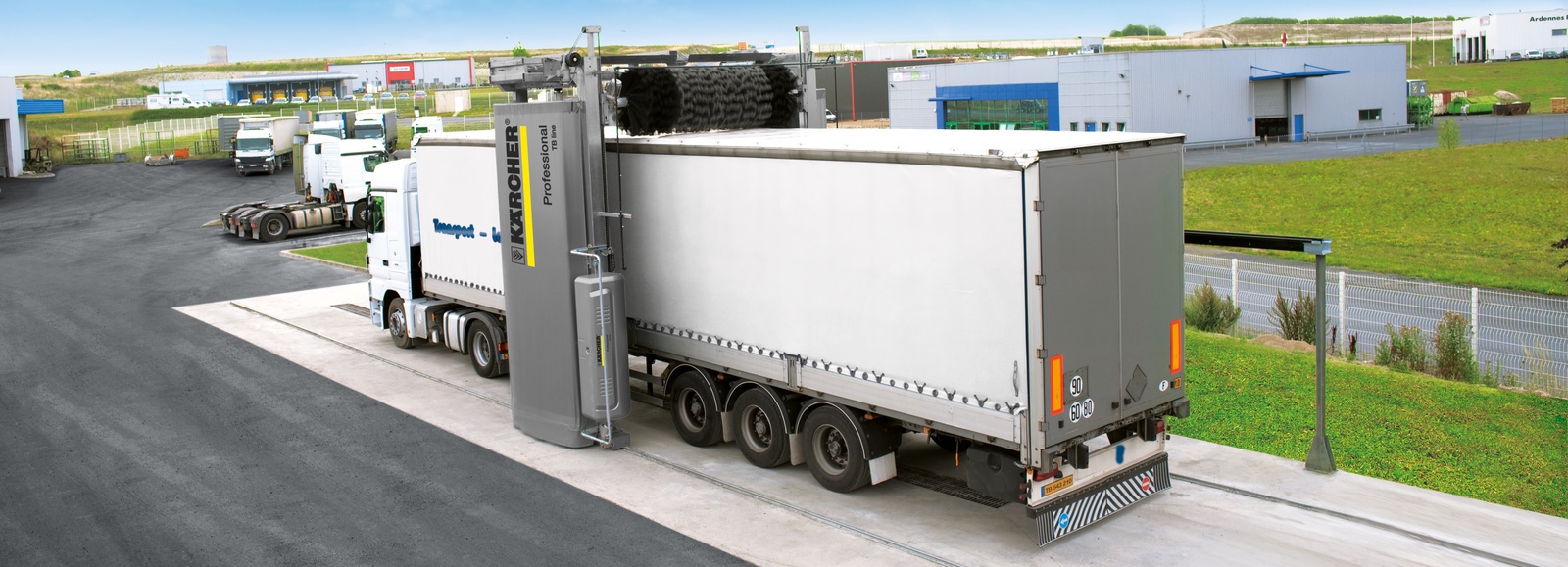
Requirements for a commercial vehicle wash
The requirements for cleaning commercial vehicles are stringent. The dirt that accumulates on trucks, etc. differs significantly depending on the purpose of use and the vehicle type. The washing technology must therefore be able to reliably and quickly remove dirt such as tar spots, oils and mud stains along with seasonal deposits (e.g. road salt, flower pollen, insect and leaf residues) while being gentle on the vehicle surface.
Another challenge is the various materials from which the trucks are manufactured, ranging from aluminium, carbon fibre and steel through to rubber and various plastics. They must all be cleaned reliably and gently in a washing process.
Time and cost savings thanks to mechanical cleaning
Mechanical cleaning helps save both labour costs and time. One efficient solution is therefore the use of modern commercial vehicle gantry car washes and wash bays with high-pressure cleaners. These use a variety of products that enable the vehicle wash to be adapted to changing requirements. Their spectrum of use ranges from a manual or mechanical prewash to a thorough main wash right through to vehicle care. This makes it possible to use cleaning agents that have been specially formulated, without which it would be either impossible or extremely time-consuming to meet the stringent requirements for a commercial vehicle wash. The use of vehicle wash systems and bays must, however, be adapted to the type, number and size of the vehicles.
When selecting and equipping a wash system for commercial vehicles, three important questions have to be answered:
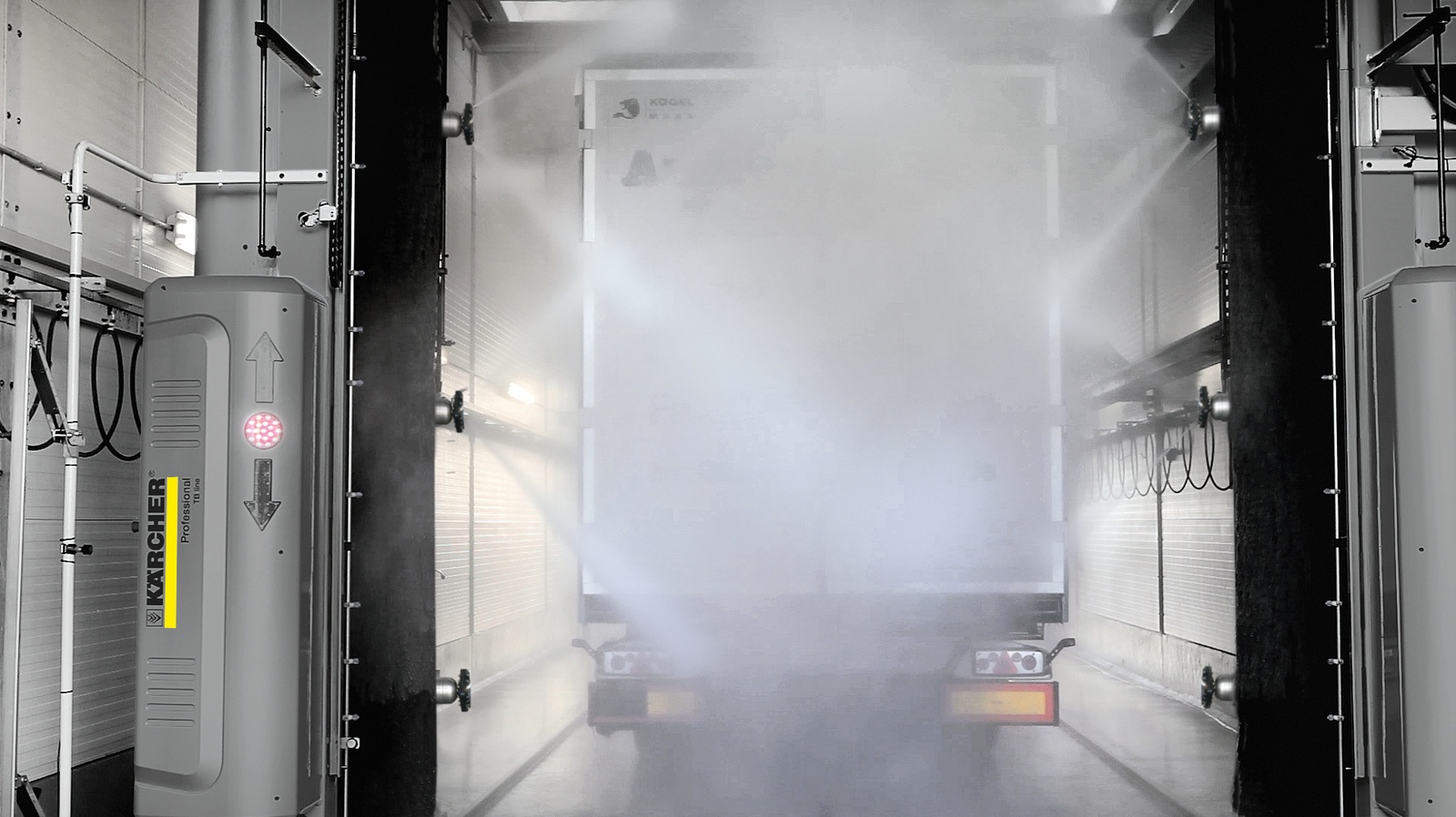
Three steps to a clean vehicle
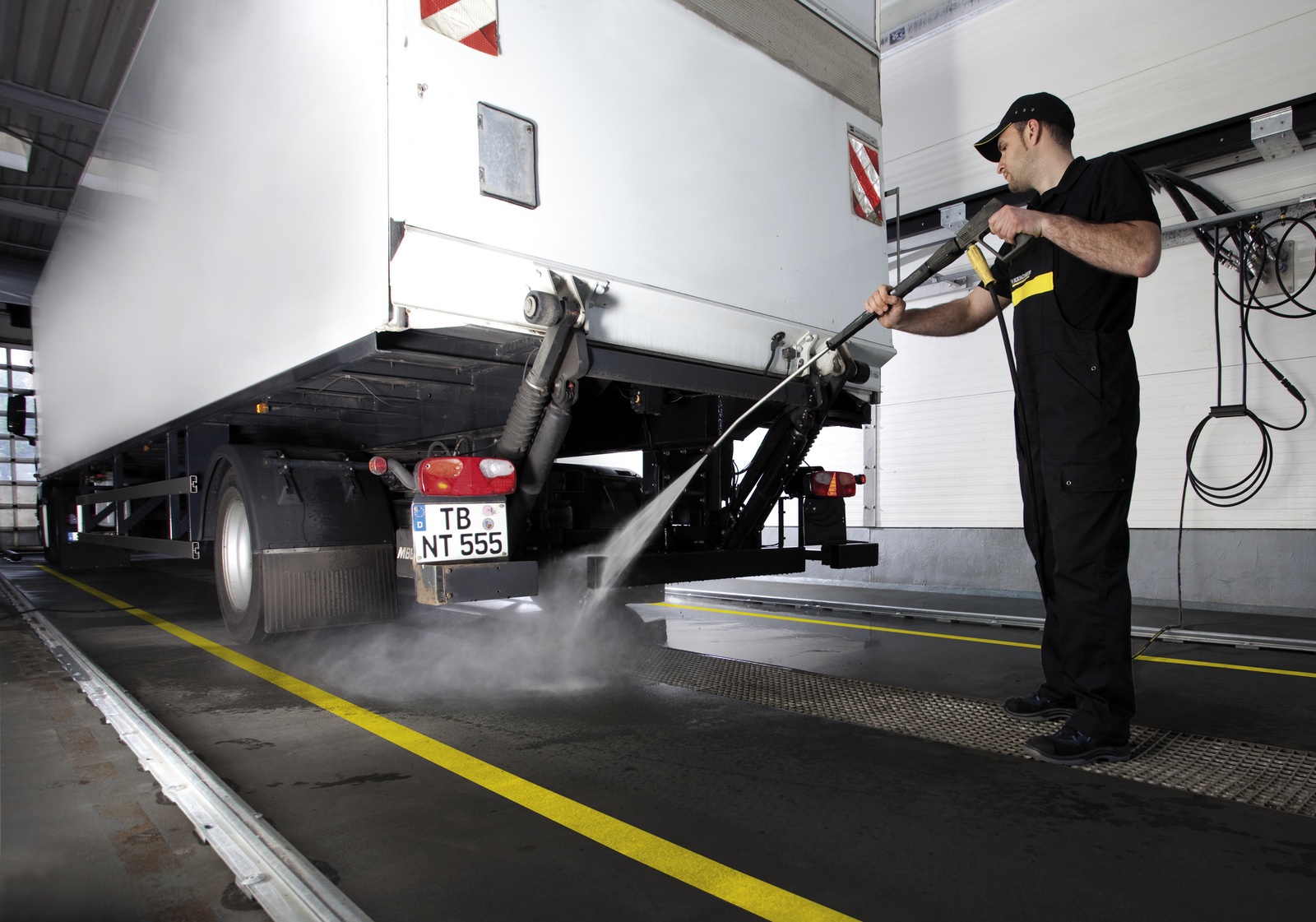
Step 1: Prewash
A high-pressure cleaner is often used to prewash commercial vehicles. Before purchasing, it must be clarified whether a mobile or stationary machine is needed. A choice also has to be made between cold water and hot water high-pressure cleaners.
- Mobile machines are more cost-effective and the fact that they can be moved around means that they can be used for many (special) tasks such as workshop cleaning. However, note that these require longer set-up times. The capacity for consumables such as fuel and cleaning agent (approx. 10 to 20 l) is also restricted depending on the system.
- Stationary high-pressure cleaners have the advantage that the water can be heated by the power supply (electricity/gas/heating oil) without any limitations. Cords and supply lines are also kept tidy at all times and the tanks for the washing chemicals are also larger, doing away with the need to refill them on a regular basis.
An alkaline truck and tarpaulin cleaner is used for the prewash. The pre-spraying agent for brush and high-pressure vehicle wash systems helps to soften and remove stubborn dirt such as grease, rust, oil, tar, insect residues and grey film. The dirt remover is either dispensed in the appropriate quantity using high-pressure cleaning machines or sprayed on thinly via the dosing system for the gantry car wash. An alkaline rim cleaner is used for the wheels if necessary.
Alternatively, it is possible to install an intensive pre-spray arch on the gantry car wash. Depending on the amount and type of dirt, this means that manual pre-cleaning may no longer be necessary.
Step 2: Main wash
During the main wash that follows the prewash, softened dirt is removed from the vehicle by three rotating brushes with the addition of water and a powerful shampoo or foam. Their active ingredient combinations help the brushes to glide and thus protect the vehicle surface. The contact pressure of the side brushes can be adapted to suit the particular vehicle which, in combination with the precise contour detection, ensures optimum washing results.
The main wash is followed by rinsing, whereby any remaining dirt and detergent residues are removed.
Alternatively, the main wash can also be carried out with a manually operated single-brush system. This cleans vehicles up to a height of 4.20 m and is suitable for fast, thorough all-round cleaning (sides, front and rear) of small fleets with up to 15 vehicles.
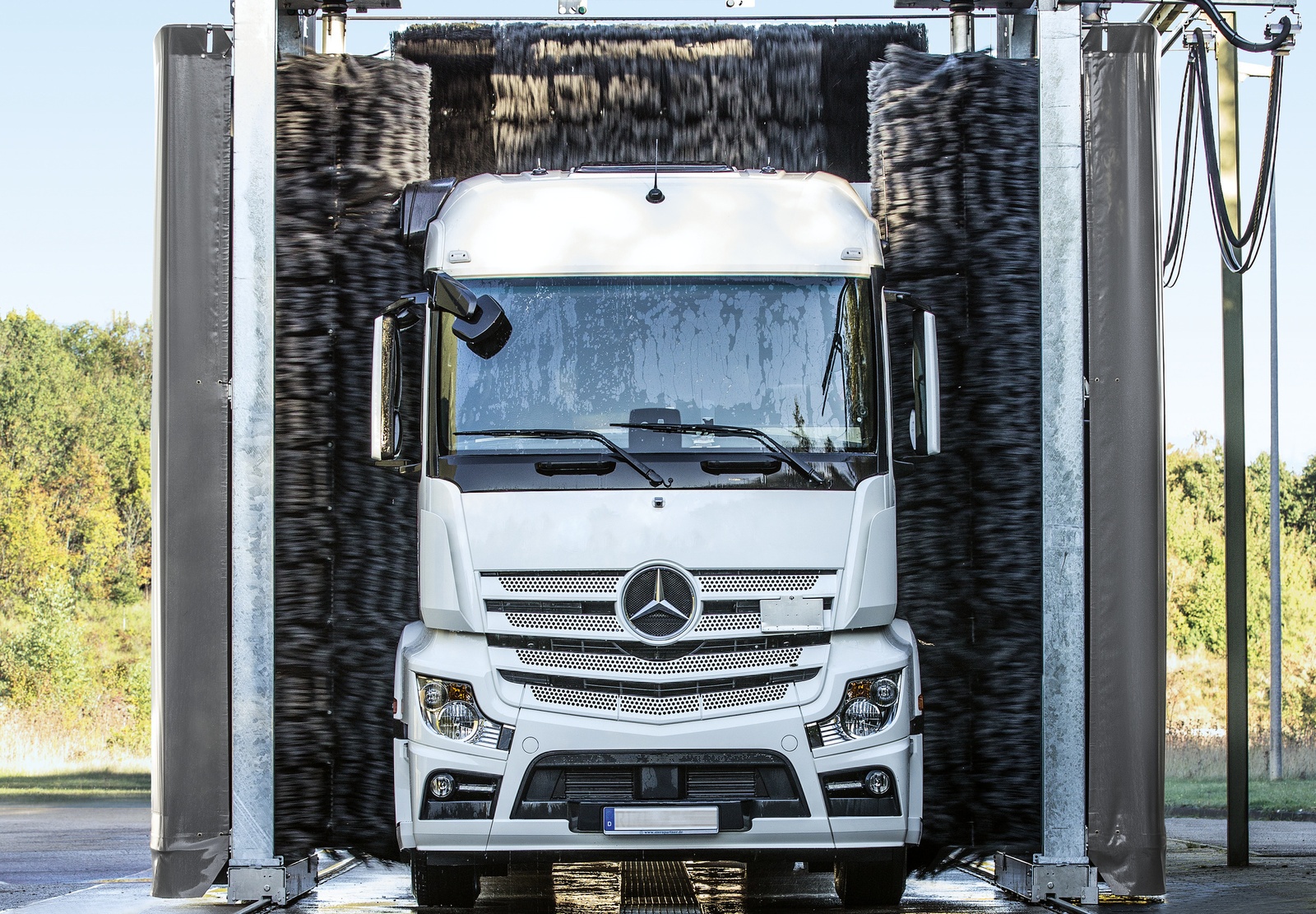
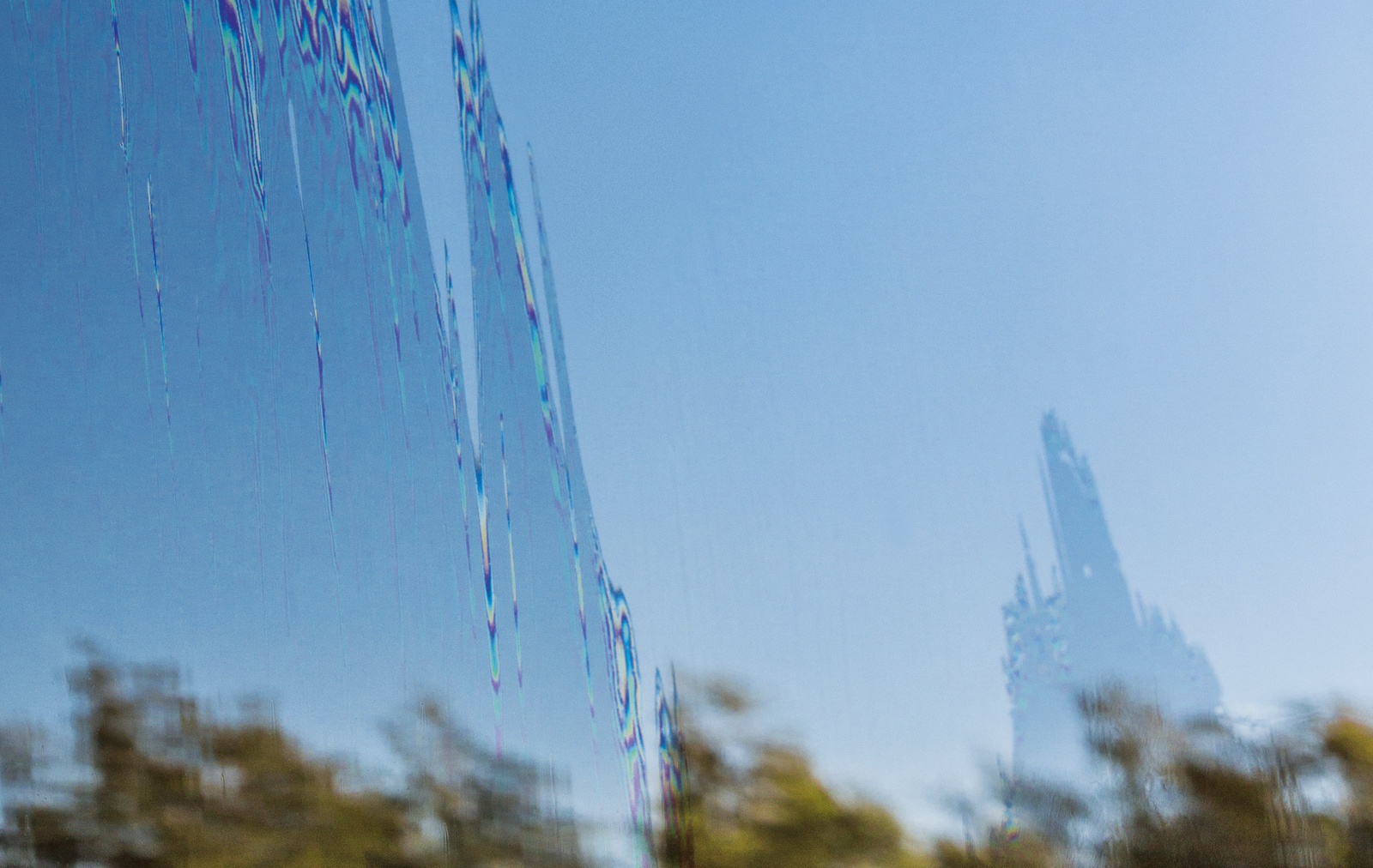
Step 3: Vehicle care
An additional programme, such as waxing, can then be selected to help maintain the truck. This protects the paint from any harmful environmental influences such as dust, acid rain or aggressive bird droppings. Wax also prevents corrosion since it flows into crevices and cavities penetrated by water and forms a protective film when it dries. Additional benefits are that dirt is less likely to stick to the paint, the vehicle looks its best for longer and is easier to clean.
Furthermore, liquid spray wax gives vehicles a brilliant shine and long-term protection. Since it is unaffected by water quality, it also provides a spotless finish after washing without blow drying. Liquid leather has been developed for vehicle wash systems without blow drying and is particularly suitable for vehicles with large visible surfaces. The product allows the wash water to flow away from the vehicle surface and windows as a thin film without leaving any marks.
Save money with the right chemicals
A majority of commercial vehicle wash systems use a water reclamation system in order to reduce fresh water consumption. This filters dirt particles out of the reclaim water, channels them away and returns the cleaned water back into the system – which can reduce fresh water consumption by up to 85 per cent. For efficient treatment of the reclaim water and safe operation of the wash system, however, the perfect match of washing chemicals is needed. This is because components such as the tank system with sludge trap, fine filtration system and reclaim water storage tank only work perfectly if they are not influenced by the chemicals. Manufacturer's specifications should always be observed.
System operators save money with the right chemicals: Additives that are selected according to individual requirements save water, which means the system runs safely and is paid off quicker. The customer also benefits from this, as a wash system with coordinated programs and cleaning agents works to the highest level of quality with a low environmental impact – and thereby helps the vehicle retain its value and has a positive impact on customer satisfaction.
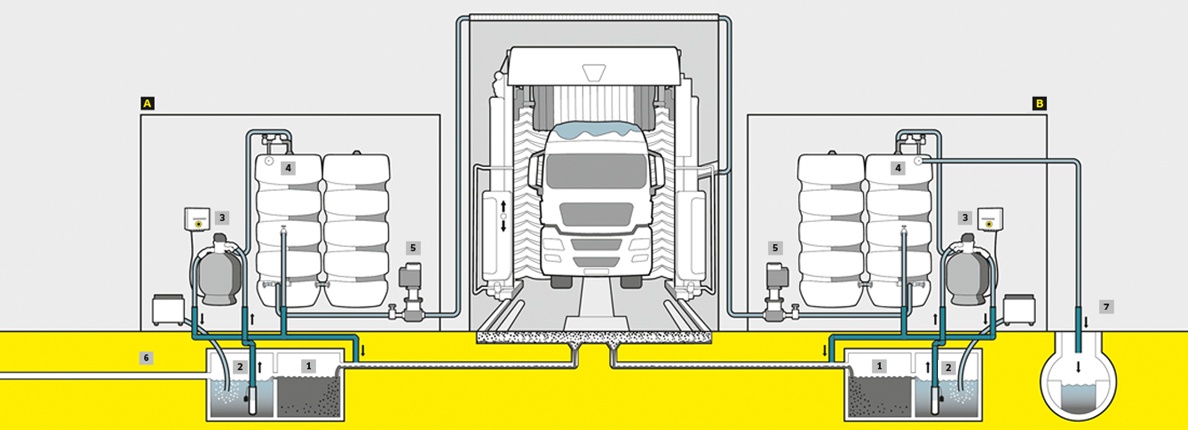
[A] Waste water discharge via basin system in sewage system | [B] Waste water discharge via reclaimed water tank in sewage system
Reclaimed water circuit: The waste water flows into a pump pit [2] via the settling pit [1]. From there, it is pumped into the reclaimed water tank [4] through the automatically back-flushable sand filter (media filter) [3] and made available for the wash process via a supply pump [5]. Depending on the applicable legal provisions, excess water can be channelled into the sewage system [6] either directly or through a separator by passing through the pump pit. The waste water can also be channelled into the sewage system directly from the reclaimed water tank [7]. In this case, there is no connection between the pump pit and the sewage system.
You may also be interested in:
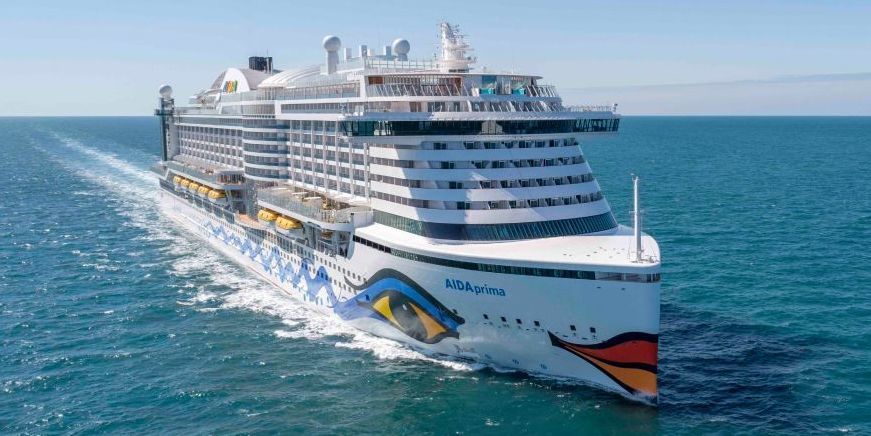
No fear of big beasts
AIDA Cruises is Germany's leading provider of sea cruises. As part of a long-term partnership with Kärcher, a detailed and well-thought-out cleaning concept has been developed to take care of everything. Increased mechanisation, the right detergents, and well-trained employees have resulted in quantum leaps in cleaning efficiency and quality.

